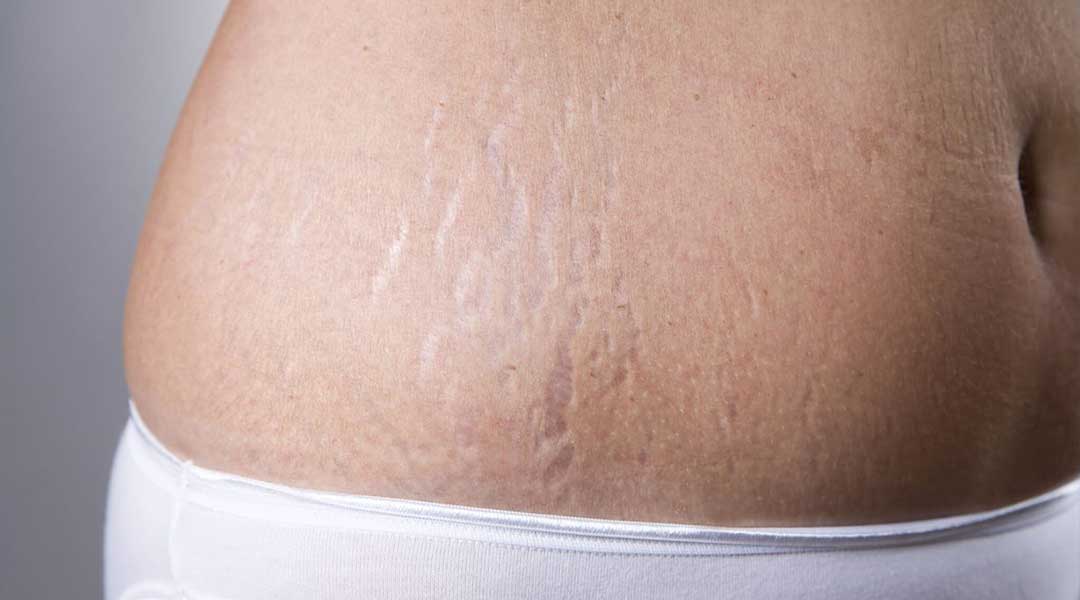Stretch marks are something that can happen just about anywhere on the body and develop when the skin stretches or shrinks abruptly. Typically, they appear as bands or lines on your skin that are a different colour and texture to your normal skin, ranging from dark purples to light greys. The bad news is that the majority of people who have them strongly dislike their appearance, but the good news is that they aren’t something that will have to stick around forever.
Commonly, stretch marks are associated with pregnancy and weight change but they are also especially prevalent in teenagers and adolescents who are undergoing puberty. They occur as a result of the stretching of the skin and can also be associated with an increase of cortisone within your body. Cortisone, while it is a hormone that is naturally produced by your body, is actually responsible for causing your skin to lose its elasticity if you have an over abundance of it.
Generally, stretch marks tend to be associated with;
- Pregnancy – many women who go through pregnancy and childbirth are affected by stretchmarks due to the way that the skin stretches to make room for a growing and developing baby.
- Weight loss/gain – rapid weight loss and weight gain are another big reason for the appearance of stretch marks as it causes the skin to stretch/shrink to match its new contour.
- Medication – certain medications such as corticosteroid creams or lotions can cause stretch marks to appear by decreasing the skins ability to stretch properly.
- Medical conditions – being affected by certain conditions such as Cushing’s syndrome or Marfan’s syndrome can affect the amount of cortisone that is present in your body which directly affects the appearance of stretchmarks.
There are also a number of factors that put you at a higher risk of developing stretch marks such as being female, having white/pale skin, having a history of stretch marks in the family or having a family history of large babies/twins, which all contribute as a negative factor towards having stretch marks.
Is there anything I can do to prevent stretch marks from happening?
Unfortunately, there’s no way at all to completely prevent the appearance of stretch marks and at the end of the day it’s all down to your skin and your genes. This isn’t to say that you can’t do anything though, keeping your weight within a healthy range, eating well and exercising on a regular basis can help you to prevent the appearance of stretch marks that are caused by gaining or losing weight suddenly.

How can I fight the appearance of stretch marks?
While stretch marks aren’t something that you can get rid of in a natural way (or at the very least it’s highly unlikely), they are something that will fade over time and eventually will be barely visible. It is possible though to fight their appearance and cause them to fade away (and in some cases remove them).
Starting at the beginning, vitamin A is something that is commonly referred to as a retinoid. Retinoids are found in many over the counter creams and can help to make the skin appear much smoother and more youthful. By using a topical cream containing vitamin A, taking it in tablet form or even opting for a diet containing things like carrots and sweet potatoes which are rich in vitamin A can all help to boost the level that is present in your body, aiding with fighting the appearance of stretch marks.
Another thing to try at home is using some form of hyaluronic acid based treatment to help boost the collagen within your skin. Collagen is the protein that is responsible for keeping the skin healthy and young and as we age, the levels of collagen naturally decrease. Hyaluronic acid stimulates the production of new collagen within the skin and, just like vitamin A creams, can in turn help the skin to reduce the appearance of stretch marks.
There also things such as coconut oil and aloe vera which, while they are not proven to help, are known to have healing properties. Unless you suffer from any allergies, these may be perfect at home recommendations to help your skin to heal which will lessen the visible signs.
Now we’ve got the home remedies out of the way (as these won’t actually completely fight the signs of stretch marks), there is actually a non-surgical method of treatment that can be used to help. Microneedling can help to improve the colour and texture of stretch marks by blending them in with the surrounding skin tissue. It can also help to reduce the size and indentation of the scarring to reduce their visibility, and while there isn’t a way to completely remove them, it’s possible to camouflage them to the extent that they are not noticeable.
Microneedling works by creating a number of microscopic injuries in the skin which prompts the natural healing response within the body to produce new collagen at the wound site. This reaction helps to heal any tears within the dermal layer of the skin that are responsible for causing stretch marks to appear.
Our final opinion is…
So, while there is no way to completely remove the appearance of stretch marks, it is possible to hide and camouflage them to the point where they are practically invisible. It’s also pretty much impossible to stop yourself from ever getting stretch marks, but it is possible to prevent them as long as possible by keeping your skin hydrated and taking good care of your body and skin.
It’s also worth noting that stretch marks will likely fade over time by themselves, at least to some level, and very rarely will they remain as prominent as they are when they first appear.

